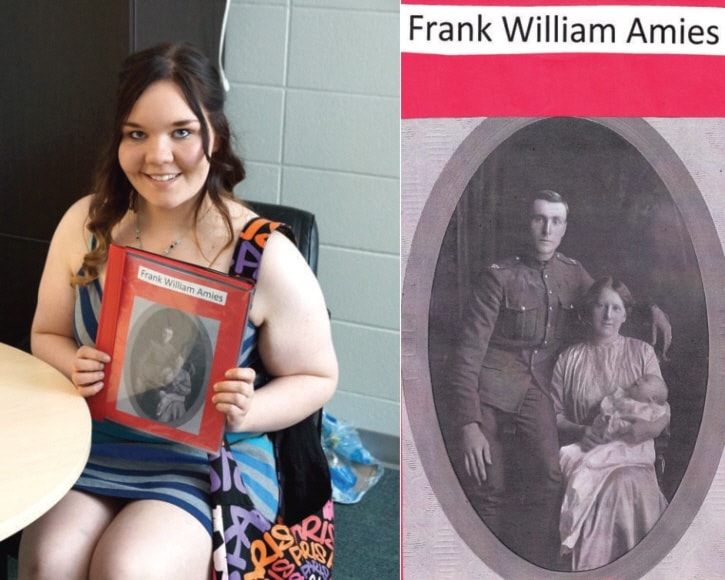“It all started with one phone call” says Percy Johansen of Ponoka, as he begins to tell the story of how a young Ponoka student developed a passionate curiosity into the life and heritage of Frank William Amies, his uncle, a young immigrant to Canada in early 20th century, whose plans to raise a family and grow roots in Ponoka were shattered by WW I.
Ron Labrie, Social Studies teacher at the Ponoka Secondary Campus, was in the process of identifying names of Canadian soldiers who fought in either of the world wars to be assigned as research subjects to students under the Broncs World Tour project.
When his efforts to gather satisfactory information about Amies failed to produce adequate information, Labrie put an ad in Ponoka News asking for people with information about Amies to come forward and, who else, Percy Johansen responded to the call.
“The name was in the paper and that happens to be my uncle, so I phoned him and told him that he was my uncle,” Johansen recollected as he began telling the story.
Although Amies was his uncle, Johansen had never seen Frank Amies and actually did not have much to offer in terms of detailed information. But there was one thing he could offer, something that would prove to be the key in opening avenues to information.
“We talked for a little while and before he hung up, I said to him that the name was spelt A-M-I-E-S and in the paper it was A-M-E-S,” said Johansen.
The correction of the spelling was what was missing in the equation; once it was identified Labrie was by all means ready to assign a research project on Amies to a student.
That student turned out to be Shelby Merrill, who said she was interested in researching the wartime story of Amies long before the spelling issue was resolved.
“I was intrigued by Frank’s story last year,” said Merrill in an interview.
She was so captured by the lone immigrant’s journey to Canada, his settling in Ponoka and meeting his future wife, Mildred and his short career as a barber before joining the war effort that she prepared an exemplary folder with information including even the last movements of Frank’s battalion during the campaign which resulted in his death.
But Merrill has not stopped with the research about Frank, and she continued pursuing the tracks through Percy’s help, which led her to information about the life of Claire, Frank’s son, left with the mother when he was only two months old and never really knew his father as he never returned from the front.
Merrill also found out that Claire also joined the campaign in WWII and took part in the bombing of Germany as a “bombardier”, returned after the war to finish his post-secondary-education, worked in the oil fields and ultimately settled in Stettler.
She now plans to find out further by pursuing her research on Claire’s three daughters, two of whom reside in Alberta with the third daughter having settled in B.C.
“Frank is not just a name to me anymore,” said Merrill, “It (the research) is not a course anymore.”
“Exactly,” Merrill responded when suggested if she now feels that she is somehow associated with story of Frank Amies and his legacy.
Percy Johansen says he is grateful to Shelby Merrill for her extensive research on his uncle’s story and his heritage as an individual.
As for Merrill, she says the research she has done on Frank will be an invaluable asset as she moves ahead on her planned career path as a social worker.
“I want to know a child’s story so I can do my job correctly, find that child a home or help that child in some way, and that is not just looking at a piece of paper about the history of that child.”
